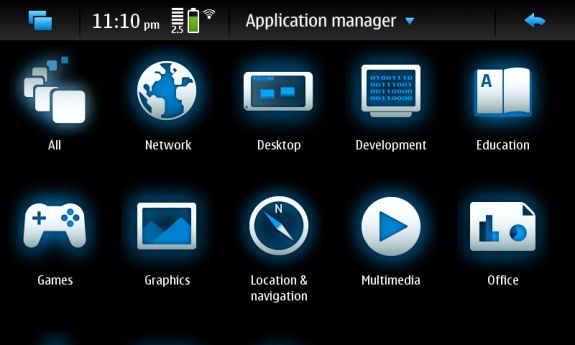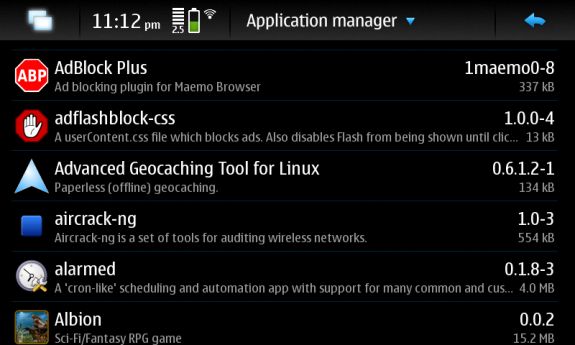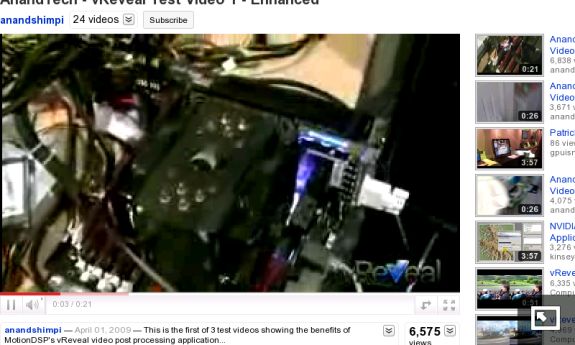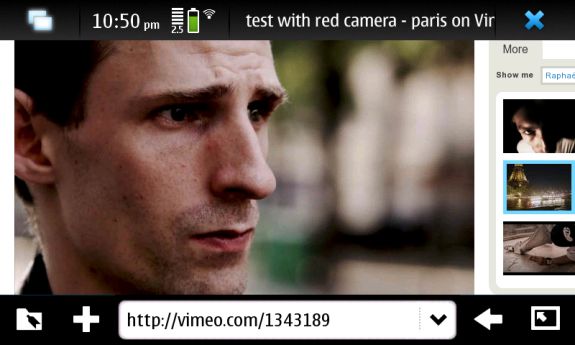Two OMAP 3430 Phones: Nokia N900 and Motorola Droid
by Brian Klug on June 10, 2010 9:29 PM EST- Posted in
- Smartphones
- N900
- Maemo
- Motorola Droid
- Droid
- MeeGo
- Android
- Mobile
Maemo's App Store
Nokia offers a simple application marketplace called the Ovi Store. In practice, this isn't anywhere near fleshed out like it should be, as launching the Ovi Store fires up the browser and takes you to the Ovi Store in the N900's browser. What's much more compelling is the Applications Manger, which is a well disguised debian package manager frontend, but admittedly polished enough to be used exclusively. You can add 'catalogs' - Nokia's parlance for repositories - from within here, and choose from a huge selection of FOSS packages that install over the air on the N900. The applications manager is every bit a graphical package manager, you can uninstall, download, and update every package on the phone.
It has categorization and feels like it was given plenty of thought, but really lacks the kind of polish other application marketplaces do on other platforms. For example - open up a big category with a couple hundred applications, and you'll find yourself scrolling for a few minutes to get to the desired one.
Take one look through the packages, and you'll know that Maemo has serious potential in the right hands - what other application marketplace has Wireshark, Kismet, Aircrack-ng and Nmap sitting unsuspectingly inside? That's awesome!
The Browser
There has been an enormous volume of debate centering around Flash on mobile platforms lately. While Android 2.2 will eventually bring full Flash 10.1 and AIR support to the entire platform, it's impressive to think about how the N900's browser on Maemo has been running full Flash 9.4 since release.
Until Froyo 2.2 brings a faster browser and Flash support to Android, it's difficult to not argue that the N900 offers the best browsing experience on the platform.
Out of box, the Mozilla-supported browser is almost all you need. There's even extension support for AdBlock Plus directly in the marketplace - and best of all? It works perfectly.
Almost all the Flash content I tried played fine, though the implementation still isn't perfect. I can understand now what Adobe means when it notes that only certain video codecs play back smoothly or are "mobile optimized."
For example, playing videos on Vimeo resulted in extremely choppy framerate and audio - the experience was unwatchable. However, YouTube videos played back perfectly, complete with audio. Hulu refuses to work on the platform, though this is likely due to the licensing issues they maintain prevent them from streaming to mobile devices. Who knows, perhaps support is just a user-agent string change away.
If the OS default browser doesn't suit you, there's also Firefox and Chromium in the marketplace.
Chromium on the N900 is very beta, but Firefox is almost good enough to supplant the normal browser. It's slower feeling, but has a very desktop feel.
















68 Comments
View All Comments
Affectionate-Bed-980 - Friday, June 11, 2010 - link
You talk about the display brightness and how nice it looks, but you need to mention gamut. In some tests the 3GS shows ~65% of gamut, while the Droid shows 102%. Nexus One is at 141%. I expect the Incredible to be around there, so while the colors look nice on AMOLED, you must remember it's over-saturated and inaccurate while the Droid is spot on at 102%.fabarati - Friday, June 11, 2010 - link
I think you've misunderstood what gamut means.When a screen is advertises as 98% of the Adobe sRGB Gamut, it means that the screen covers 98% of the colours defined by Adobe for that gamut..
If it says 141% of the Adobe sRGB gamut, it means that it covers more than that defined area. It doesn't mean that the colours are oversaturated. It also doesn't mean that it can display all the colours there is.
Read up on gamuts on wikipedia:
http://en.wikipedia.org/wiki/Gamut
Powerlurker - Friday, June 11, 2010 - link
On the other hand, I doubt that anyone is going to do color correction or some sort of display calibration on their smartphone, and since most companies set their displays to be somewhat saturated by default, I would guess that in practice the Incredible's AMOLED screen will be oversaturated compared to the Droid's LCD.Brian Klug - Friday, June 11, 2010 - link
So here's the problem - there's absolutely no way to measure it. Or at least, I haven't found an acceptable solution.Going off the display panel numbers seems extremely unrealistic for obvious reasons, but barring that there are other bigger problems.
1. Android uses 16-bit color in a lot of places because they're rendering them with 3D OpenGL compositing and compressed textures. One of the most glaring - and dare I say troubling - examples is right inside the gallery application. The gallery application in 2.0.1 was full 24-bit color, but in 2.1 Google contracted with Cooliris to develop a more flashy 3D gallery. Obviously, the limitations imposed by the GPU on different devices (and possibly even from the POV of what textures are supported) necessitated 16-bits per color. In practice, it just looks awful. Without even being nitpicky, I can notice lots of banding.
2. The AMOLED displays use the PenTile array, which also does a lot of dithering inherently - in fact, their pattern is essentially trying to get around Nyquist by being very creative with the human eye system, and this intermediate software layer of theirs. The consequence is that it ends up smoothing and dithering the 16-bits, making it really hard to see the banding, but it's still there. Pull up the color gradient images from the article and scrutinize the Incredible. There's no banding, but in person, you can stlll pick out dithering and a problem.
3. I still have no way of doing gamut testing on any mobile devices. So back when I started on the iPad article, I had a (relatively clever, I think) idea to use the calibration software through a 24-bit remote desktop session, tricking it into using any mobile device like a screen. This just doesn't work for reasons outside my understanding. I've done it on iPhone OS and Android, and for some reason the results are just complete bogus. So there's no way of really telling what the % gamut coverage of Adobe 1998 any of these things are. Moreover, since there's no way of loading a display profile on them, you're really stuck with whatever it shipped with anyways.
The sad state of things is that AMOLED "looks" brighter and more contrasty, but the color accuracy is just undoubtedly wrong. I mean, it's obvious to make that comparison when you're surrounded by calibrated IPS panels with Delta-E tracking under 1.0, you hold up any of the phones, and see a veritable library of differently hued photos.
I'm open to any suggestions you guys have for really measuring gamut. I mean, we could try being more manual and laboriously testing colors one by one (that's basically how I do brightness - white, black, and contrast) but, is it worth it?
KevinToon - Friday, June 11, 2010 - link
Shouldn't the speakerphone testing be done with the devices suspended off the desk??I know my phone sounds different if it's on a hard surface like a desk.
R3MF - Friday, June 11, 2010 - link
I have an n900, so thanks, good article.Found an interesting MeeGo article since you mentioned it:
http://jedibeeftrix.wordpress.com/2010/06/06/ultim...
medi01 - Friday, June 11, 2010 - link
May I ask why 3GS is missing from "side by side comparison"? Just an incident or you are THAT afraid of Mr Jobbs marketing's wrath?dtreader - Friday, June 11, 2010 - link
Wow! Just moments after finally placing my order for an N900 about eight hours ago (I've been lusting over this phone ever since it was just rumored to exist), I noticed this article on AT, with no comments having been posted to it yet. Cool, huh?I have a feeling there are many people like me....people that have been thinking about purchasing this incredible phone, but have been holding back for various reasons: for the price to come down a bit, to see how Nokia supported it with software updates, to find out about bugs and if they're being fixed, to feel comfortable about the future of Maemo on the N900 and, at this point, feeling comfortable about buying this phone even if Nokia comes out with something better in a few months time.
I've been depending daily on my flip phone/N800 tablet combination for a few years now, and have been dying to step up to the next level, even before I knew that would come in the form of the N900. A few months ago I looked at the Droid (currently I'm with Verizon), and lately considered the htc EVO on Sprint, but when you combine the current capabilities and the exciting future of the N900 (thanks to its truly open philosophy and dedicated enthusiast/developer base), I just couldn't wait any longer to get on board! T-Mobile 3.5G here I come!
Thanks for this article, Anandtech! You've been my main "source for hardware analysis and news" for over ten years now! :)
Go N900!!!
milli - Friday, June 11, 2010 - link
"From a performance perspective, the Motorola Droid's 550 MHz Cortex A8 simply isn't a match for the 1 GHz A8 in Snapdragon's Scorpion CPU ... "That should read: ... for the 1 GHz Scorpion CPU in the Snapdragon ...
There's no Cortex A8 in the Snapdragon.
Brian Klug - Friday, June 11, 2010 - link
That's being a bit semantic I think.Inside the Snapdragon is a Scorpion, which is Qualcomm's trade name for their hardened (1 GHz supporting) Cortex A8 CPU.
Cortex is the ARM Family, ARMv7-A is the family, and Cortex A8 is the fully qualified core name.
So really, either one is correct ;)
-Brian